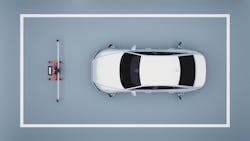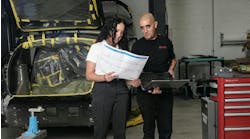An Insurance Institute for Highway Safety (IIHS) study on the risk of uncalibrated windshield cameras and their effects on advanced driver assistance systems (ADAS) such as Lane Keep Assistance and Front Collison Warning systems highlighted many key issues when servicing these systems. One perhaps overlooked but vital aspect to correct ADAS component calibration is the importance of following OEM specifications to the letter.
The study involved the testing of replaced windshield-mounted cameras. The issues explored in the test included how the systems behaved when non-OEM glass was used and if the replacement cameras were incorrectly installed. In one vehicle test, it was found that the autobraking system failed because the technician did not follow the vehicle manufacturer’s calibration instructions, including positioning the vehicle from the target at the exact specified distance. In the words of the IIHS senior test coordinator, “they were just eyeballing it.”
The IIHS used a Honda Civic for this test. The vehicle was brought to the dealer to have its windshield replaced and the camera remounted. For its test, the IIHS wanted the camera bracket to be installed misaligned on the vehicle but calibrated to OEM specifications.
The test coordinator said in the study that 0.6-degree misalignment could be compensated for in a correct calibration, and the camera should function correctly within the Collision Warning System. IIHS tested the autobraking of the Civic travelling at 25 mph. The system, when working correctly, would emit an audible warning at 124 feet or 3.4 seconds before impact and begin braking automatically if the driver took no action at 53 feet or 1.5 seconds before impact. This test vehicle didn’t alert the driver until 102 feet from impact, leaving the driver with just 2.8 seconds to respond. The vehicle didn’t start autobraking until 32 feet and 0.9 seconds from impact, resulting in a collision with the obstacle at 20 mph.
IIHS’s test coordinator went back to the technician and found that the technician failed to follow many steps in the static calibration. The test coordinator quoted in the study said, “The center of the car needs to be determined and projected out in front of it, and then the camera told where that is. This was the step the dealer failed to do until I helped them.”
This story speaks to a very human failure: We don’t like to follow directions. And as someone who writes guides and manuals, I had to find the reason why failing to follow ADAS calibration instructions can have such tragic consequences.
Of the many reasons given to why we often fail to follow instructions, I believe the main reason is we often don’t know the reason for the instruction or procedure. And without knowing the purpose of the step, we assign it little value and therefore choose to dismiss it.
To this, let’s review what happens during a front-facing camera calibration and try to understand the “whys” behind the facility requirements, the vehicle conditions, and the procedural instructions set forth by most vehicle manufacturers.
The typical static calibration requirements insist that the vehicle be on a flat, level surface. And, in the case of a camera calibration, it should be done in a bright, controlled-lighting environment. The area behind the calibration targets should be clear and clutter-free. In the case of radar calibration, no metal objects should be within the calibration space.
The “whys” of these requirement seem straightforward — we are calibrating a camera with a target that has a white background and a black image upon it. We want to create the most ideal setting for the cameras to “see” the targets. Dim, uneven lighting or glare will hinder the camera’s ability to recognize the targets. Additionally, there should no clutter, signs or photos behind the target, as they might “confuse” the camera. If we are calibrating radar devices —components meant to detect metal objects — we don’t want to have other metal objects in the vicinity of the vehicles radar unit and the positioned calibrator. In a shop environment, this might mean moving metal garbage pails, tire machines, or toolboxes to another space in the shop.
And how important is it that the calibration be performed on a flat, level surface? Really important, as one aspect of the positioning of the target to the vehicle is dependent on the vehicle’s rear drive line. An uneven floor might throw off the pitch of the vehicle and may result in an improper calibration. (When an alignment rack is used during calibration, the technician would be prompted to enter the height of the rack from the floor into the calibration software on the scan tool. An adjusted target position height is calculated and displayed.)
The next step before a calibration is to ensure that the vehicle itself meets a list of conditions including that all fluids are at recommended levels, the gas tank is full, the tire pressure on all tires is at the placard-listed psi, and that that vehicle carries no additional load — no groceries, no luggage, no heavy equipment.
The “why” here is perhaps a little less straight forward, but Autel Head ADAS Trainer George Lesniak offers the best rationale — that these prescribed conditions seek to emulate the “stance” of the vehicle when it left the factory floor and went on to be calibrated. The OEM is in essence saying that the camera or radar components were initially calibrated when the vehicle met these conditions, and to ensure these input components perform as designed to inform the operation of the system, these original pre-calibration conditions must be met. Failure to meet these conditions may compromise the calibration and therefore compromise the effectiveness of the safety system overall.
Additional prescribe conditions include ensuring that all lights are off in the vehicle and all doors are closed. This is to ensure the vehicle battery is not drained during the calibration. For the same reason, a battery maintainer should be connected to the vehicle.
The next step prior to the calibration is to ensure that the target is positioned correctly to the vehicle. As an example, Autel’s standard calibration frame system uses lasers, mirrors, rear wheel clamps and a tape measure to position the frame to vehicle. The technician uses the center laser on the frame to first detect the center line of the vehicle. A measuring tape is used to ensure that the frame is at the distance to vehicle specified by the OEM. Next, the rear wheel clamps with lasers are used with the frame to ensure that that the crossbar (and subsequently the OE-specific target when attached) is perpendicular to the rear axle of the vehicle. Then, the clamps and frame are used again to ensure that the angle of the frame is positioned to the drive line of vehicle.
Why are all these steps performed? Because it is the thrust angle — the angle generated from the vehicle’s rear axle — that dictates the direction of the vehicle as it ventures down the road. Our frame is positioned to the reference point of the vehicle thrust angle.
This pre-calibration is the most time-consuming step of the entire calibration procedure. The actual camera calibration takes just minutes.
One thing missing from the IIHS study was the lack of a reason from the technician for not following the OEM directives. Perhaps he lacked the right tools or equipment, or he simply found the measuring process too time-consuming and/or tedious and decided to take a shortcut. While the excuse is unimportant, it’s true — the setup processes for the ADAS calibrations are time-consuming and tedious.
Calibration systems developers have heard technicians’ lament and answered with new systems or adaptions for existing ones that not only drastically cut the setup time but also ensure a more precise positioning of the vehicle. However, no matter what system your shop uses, following OEM directives will always be a must to ensure a quality repair, and, most importantly, the safety of your customers.




